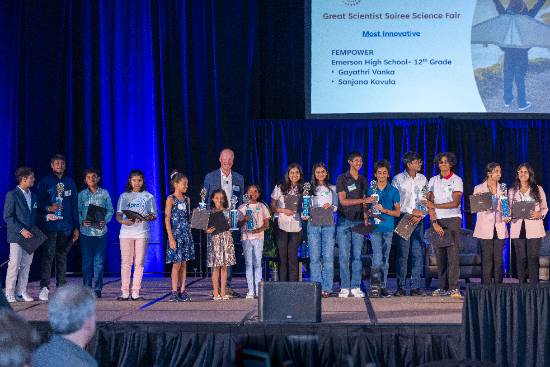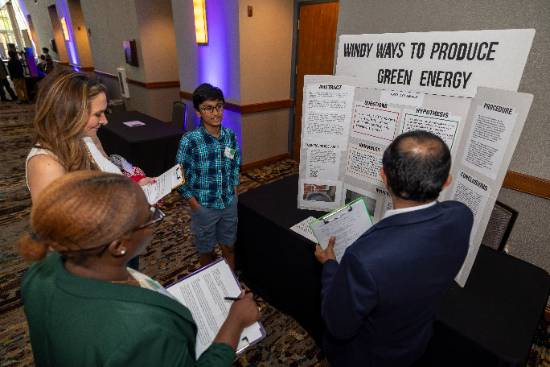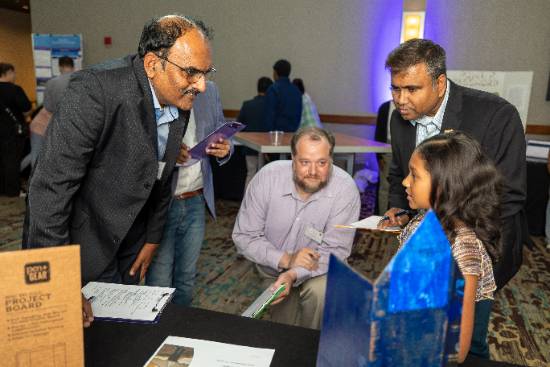Innovative Young Inventors Take Center Stage at UNT Dallas-Wipro K-12 Science Fair
September 08, 2023
Some of the brightest young minds in North Texas shared the stage at the inaugural “Great Scientist Soiree” co-hosted by UNT Dallas and Wipro, a leading technology services and consulting company with an extensive presence in North Texas.
Talented elementary, middle and high school students demonstrated their ideas, posed for photographs and received trophies. The fair showcased 35 projects by 53 students from first grade to high school sophomores attending 27 schools. It was held Aug. 30 in Frisco.

“The School of Education is very grateful for the Wipro partnership and we were honored to be a sponsor of the event. I had the opportunity to speak with some very innovative young scientists who obviously put a lot of time and energy into their presentations, depicting some very complex ideas,” said Dr. Christine Remley, dean of the UNT Dallas School of Education.
“I was impressed to see such ingenuity on display at the Great Scientist Soiree, the students’ love of science shone through. Events like these remind us of the importance of championing STEM subjects to drive innovation,” said Subha Tatavarti, Chief Technology Officer, Wipro Limited.
Although their designs and creations were different, these exceptional students have one thing in common. Their passion for science and STEM-related disciplines. It unites them. That means the next Einstein, Curie, Carver or Molina might be among these rising inventors.

Many projects focused on climate change, protecting the environment, health, and wellness. Others addressed infrastructure, utilities, and technology for use at home and by first responders. Most incorporated artificial intelligence (AI) and mobile app functionality.
Environmental concepts included a plan by Yashashri Kancharla, a fourth grader at McSpedden Elementary School in Frisco, to repurpose abandoned buildings by reusing bricks and concrete to construct new, energy-efficient homes while planting a large number of fast-growing trees to help reduce the planet’s carbon footprint.
Addressing climate change was also the goal of eighth-grader Rishaan Ravhavnath from Lawler Middle School in Frisco. He built an energy-saving app to cut power usage when people are not home by switching off electronics, lights, and other appliances and devices left on unnecessarily.

Pratik Chamala, a sixth grader from Stafford Middle School in Frisco, proposed mini windmills that would be placed inside HVAC ducts so their rotation would generate electricity during the use of heat or air conditioning, just one way he showed judges how to produce green energy.

Shiana Raghavnath, a first-grade student at Talley Elementary School in Frisco, who was the youngest contestant, created a “Pollinator Hotel” with water, seeds and grains to provide food that would attract bees, butterflies and hummingbirds. As judges listened intently, she explained the purpose of her project and why she chose certain materials and ingredients.
Siblings Owee and Rujita Padalikar, tenth and twelfth graders at Coppell High School in Coppell, warned about plastic pollution, such as microfibers, phthalates (often called plasticizers) and microplastics, which can take hundreds of years to degrade. Their solution: reduce the amount of products we make and use containing those chemical-based materials.
Three projects were based on water. One, by Kevin Melton, a fourth-grade student in the Grand Prairie Independent School District (ISD), experimented with different-sized bowls of saltwater sitting in the hot summer sun to determine which bowl would extract the largest amount of fresh water, leaving the salt behind. He reached an unexpected outcome: the smallest bowl yielded the most fresh water.
Kevin’s brother Stephen, an eighth grader, tried a different experiment with water. He tested several materials to see which one or combination was most effective for filtering pond and tap water. He determined a three-step process using gravel, then sand and finally charcoal was the best option.
The third water project, by sixth-grade student Aditya Tiwari from Allen ISD, conceived an engine powered by water instead of petroleum or natural gas. He noted the world has an abundant supply of water but a limited supply of fossil fuels. Aditya’s motor would use an “electrolyzer” to separate hydrogen and oxygen from the water, then use the hydrogen to power batteries to operate vehicles.
Transportation was also on the mind of Maurya Srideep Adair, an eighth-grade student at Renner Middle School in Plano. He imagined an AI-controlled self-driving car, similar to the autonomous vehicles from Waymo already on the streets of San Francisco and Phoenix.
Artificial intelligence was also the foundation for an automated trash bin created by Ahaana Thakur, a sixth grader at Vandeventer Middle School in Frisco, and a “Smart Robot” envisioned by seventh grader Anushka Chattopadhyay from Lawler Middle School. Her device was designed with first responders in mind and would analyze maps, topography and terrain, weather conditions, chemicals, fluids and liquids, smoke, fumes, gases and other products, materials and conditions that could be hazardous to emergency workers.
Nearly a dozen young inventors focused on medical care, personal health, and wellness. They emphasized disease management, prevention of illnesses, early detection of potentially dangerous conditions, and mental health treatment.
Although none claimed or intended to diagnose a serious health issue, they did aim to spot early-warning symptoms and signals and, ultimately, save lives by directing users to medical professionals.
One of the largest teams at the science fair showed off their HealthSense app. It was created by Lawler Middle School eighth graders Aadi Soni, Aryan Sharma, Shrey Jain and Shourya Kancharla, whose goal is to reduce the number of misdiagnosed illnesses. Using data from six people, they developed an elaborate dichotomous symptom key, which performs a comparative analysis of patient profile information. The students' ambitious target is for their app to exceed a 95-percent accuracy rate.
Another four-person team of students from different high schools (Frisco Centennial, The Hockaday School in Dallas and Greenhill School in Addison) who attended middle school together, invented the Aware Patient Portal. Sanjana Rajaram, Aanya Naini, Saanvi Hosmani and Shriya Nadagouda were inspired to make the web-based service in part because of health problems suffered by family and friends. It is programmed to help detect illnesses including diabetes, heart disease, breast cancer and melanoma by analyzing risk factors, along with answers to questions asked of users and other data, all combined to generate a 1-5 point scale of likelihood.
The ninth-grade duo of Sai Produtor and Abhirama Sonny designed and built a wearable device called Health Buddy, similar to a necklace. By touching it with your finger, it measures heart rate, blood oxygen levels and other conditions through veins and is powered by a small battery like the ones used in watches.
Other projects included AI-powered devices to detect skin and lung cancer, and to manage diseases, pulling curated, accurate information from credible, trustworthy sources.
Eighth grade student Prahas from Vandeventer Middle School researched the effects of gaming on blood pressure. He used himself as the subject of study. Prahas tested his blood pressure after playing games on five days and found it was elevated four out of five times. He concluded that gaming causes stress, so he quit and got a dog to occupy his spare time.
Another way to relieve stress and anxiety is yoga. Centennial High School junior Shaaran Balamurugan proved it. For his project, he wanted to find out if there is a connection between practicing yoga and mental health. Shaaran tested 31 people and 29 of them reported feeling less stressed after doing yoga exercises.
Improving mental health was also the goal of Gayathri Vanka and Sanjana Kavula, seniors at Emerson High School in McKinney. They’re “Project Pink” addressed women’s mental health and ways to access counseling, therapy and other treatments.
Judges of the Great Scientist Soiree awarded 10 projects and 17 students for their imagination, ingenuity and innovation. The winners included:
HIGH SCHOOL
- First Place: Saharsh Tavva and Abhinav Gopalakrishnan, sophomores at Centennial High School, for their project about the use of ChatGPT
- Second Place: Abhirama Sonny and Sai Produtor, ninth graders at the Lowery Freshman Center, for Health Buddy
- Third Place: Rujuta and Owee Padaliker, sophomore and senior from Coppell High School, for “The Manmade Poison” exhibit about plastics
MIDDLE SCHOOL
- First Place: Prahas Kumar, an eighth grader at Vandeventer Middle School, for his research about the effects of gaming on blood pressure
- Second Place: Lawler Middle School eighth graders Aadi Soni, Aryan Sharma, Shrey Jain and Shourya Kancharla for their HealthSense app
- Third Place: Anushka Chattopadhyay, a Lawler seventh grader, for her Smart Robot invention to assist first responders and warm them of hazardous conditions
ELEMENTARY SCHOOL
- First Place: Yashashri Kancharla, a fourth grader at McSpedden Elementary School in Frisco, for her idea about building new homes with repurposed materials and planting trees to reduce the carbon footprint
- Second Place: The “Pollinator Hotel” created by Talley Elementary School second-grader Shiana Raghavnath to encourage the pollination of plants by insects and birds
- Third Place: A project called “Can I Train My Cats” by Grand Prairie ISD fourth grader Kiana Melton who experimented with cat food and bubbles to see the effects on her pet
MOST INNOVATIVE
- Gayathri Vanka and Sanjana Kavula, seniors at Emerson High School, for their “Project Pink” focused on women’s mental health
All participants learned from the experience, whether they took home a trophy or not. It was a wonderful and valuable opportunity to show off their inventions, polish their public speaking and presentation skills, check out other students’ projects, and network with educators and Wipro team members.
“I’m proud of Wipro’s sponsorship of UNT Dallas’ Science Educator Fellowship program to recruit, train and develop science teachers of the future,” Tatavarti said, referring to the university’s commitment to STEM curriculum and the support of elementary, middle and high school leaders in the heart of southern Dallas.
“There is great hope for the future and the work of the UNT Dallas and WIPRO partnership is an important part of supporting K-12 students through their teachers in the classroom, Dr. Remley added.
The event was such a success that plans are already underway for the second Great Scientist Soiree in 2024. You can be sure it will be inspiration for these brilliant young minds and others to follow in their footsteps on a path to fulfilling careers and making the world a better place.